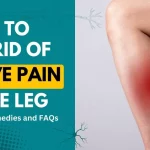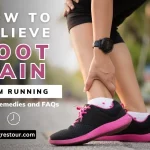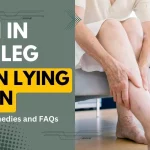Running is a great form of exercise that can improve cardiovascular health, strengthen muscles, and burn calories. However, it can also lead to various foot pains and injuries if not done properly. Foot pain from running is very common, but can usually be treated with self-care techniques, proper running form, supportive shoes, and scaling back mileage. In this article, we will explore how to relieve Foot pain from running and explore causes, and home remedies.
Causes of Foot Pain from Running
There are several potential causes of foot pain from running:
Plantar Fasciitis – Inflammation of the plantar fascia, the thick band of tissue that runs along the bottom of the foot. Caused by overuse and strain. Symptoms include pain in the heel or arch, especially when getting out of bed or standing up after sitting.
Achilles Tendinitis – Inflammation of the Achilles tendon that connects the calf muscles to the heel bone. Pain, stiffness, and swelling near the back of the heel.
Stress Fractures – Tiny cracks or fractures in the foot bones, often the metatarsals, caused by repetitive impact. Aching or stabbing pain that gets worse with activity.
Bunions – Misalignment of the big toe joint causing a bony bump on the side of the foot. Can rub against shoe and cause pain, swelling, and numbness.
Morton’s Neuroma – Thickening of tissue around a nerve between the toes, often between the 3rd and 4th toes. Causes burning or shooting pain.
Blisters – Friction from shoes can cause fluid-filled blisters on the feet. Very painful.
Heel Spurs – Calcium deposits on the heel bone that cause pain under the heel.
Shin Splints – Pain in the lower legs from repeated muscle and impact stress. Can radiate into the feet.
Poor fitting shoes, mileage that is too high, hard running surfaces, high arches, flat feet, and weak muscles can all contribute to these types of foot pains.
Remedies and Treatments
If you are experiencing foot pain from running, there are many remedies and treatments that may help alleviate the pain:
Rest – Take a break from running to allow your feet to heal. Cut back on mileage or avoid running for 1-2 weeks.
Ice – Apply ice packs to the painful area for 15-20 minutes several times per day to reduce inflammation.
Stretching – Stretch your feet, ankles, and calves thoroughly before and after running.
New shoes – Make sure your shoes fit properly and replace them regularly (every 300-500 miles). Consider visiting a specialty running store for an evaluation.
Arch supports – Orthotics or over-the-counter arch supports can help provide stability and distribute impact.
Night splints – Splints worn at night can gently stretch the plantar fascia and Achilles tendon to reduce morning pain.
NSAIDs – Nonsteroidal anti-inflammatory drugs like ibuprofen or naproxen can temporarily reduce pain and swelling.
Proper form – Focus on good running form by landing gently on the mid- or fore-foot, increasing cadence, and avoiding over-striding.
Low-impact exercise – Try low-impact activities like swimming, cycling, or elliptical to maintain fitness while recovering.
Massage – Massaging and rolling the feet can increase blood flow and relax muscles.
Physical therapy – Working with a physical therapist can help identify biomechanical issues and prescribe rehab exercises.
Corticosteroid injections – For severe cases, steroid injections can provide temporary relief.
Surgery – Surgery may be considered for bunions, neuromas, or Achilles tendon issues if other treatments are not effective.
Taping – Athletic tape applied by a professional can support the foot and decrease pain.
In conclusion, addressing foot pain from running is essential for a more enjoyable and sustainable exercise routine. By implementing simple remedies, you can alleviate discomfort and continue to pursue your fitness goals with confidence.
Pain in Foot that Shoots Up Leg
Frequently Asked Questions
Here are some common questions related to relieving foot pain from running:
What causes runner’s heel pain?
The most common cause of heel pain in runners is plantar fasciitis. Other potential causes include Achilles tendinitis, heel spurs, and heel stress fractures.
What should I do if my foot pain doesn’t go away with rest?
See a podiatrist or sports medicine doctor if pain persists longer than 2 weeks of rest. You may need imaging tests, custom orthotics, injections, or physical therapy.
How can I avoid foot pain when running long distances?
Train gradually, replace shoes regularly, use proper form, run on softer surfaces, stretch and strengthen feet and legs, and get fitted for supportive running shoes.
When should I replace my running shoes?
Most experts recommend replacing running shoes every 300-500 miles. Keep track of mileage and replace them sooner if the midsole looks compressed or unevenly worn.
What are the best shoe inserts for plantar fasciitis?
Good options include OTC arch supports, custom orthotics, heel cushioning cups, and inserts with metatarsal pads. Visit a podiatrist for recommendations.
Should I stop running if my feet hurt?
It’s generally best to take 1-2 weeks off from running to allow overuse injuries to heal. Cross-train to maintain fitness. See a doctor if pain persists longer than 2 weeks with rest.
Is it better to run on a treadmill or outside surface?
Treadmills provide consistent cushioning, while pavement is hard and can aggravate foot pain. Run on soft surfaces like trails, tracks, or grass to reduce impact.
Can icing your feet help with recovery?
Yes, ice can reduce inflammation that contributes to plantar fasciitis and other running-related foot pain. Ice for 15-20 minutes after activity.
What are some stretches that can prevent running foot injuries?
Key foot stretches include calf stretches, heel cord stretches, arch lifts, and toe stretches. Also strengthen feet and core muscles.
How tight should running shoes fit?
Shoes should fit snugly in the heel with enough room to wiggle toes. Feet swell while running so don’t fit shoes too tightly. Thumb width between toes and end.



